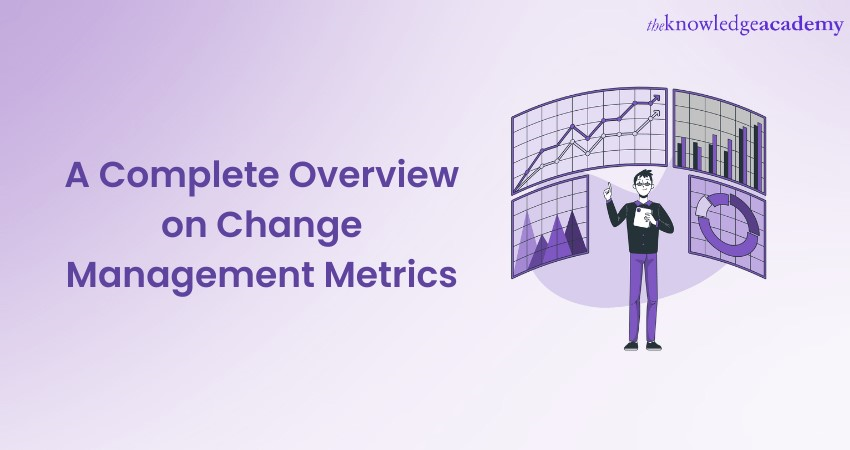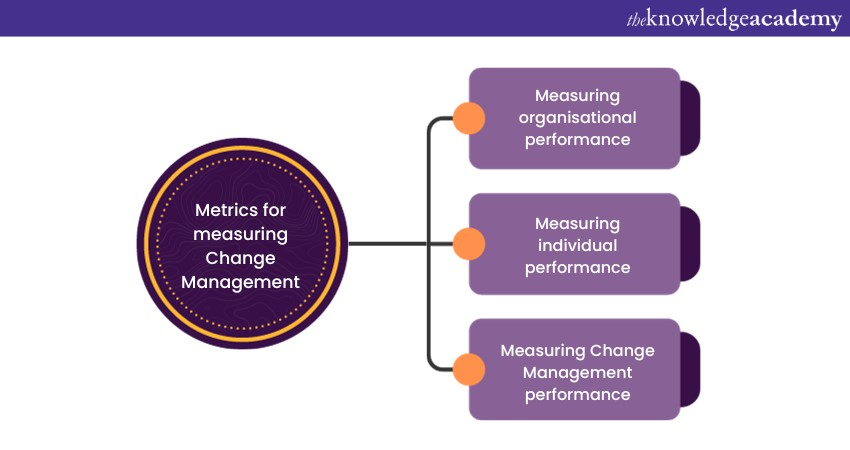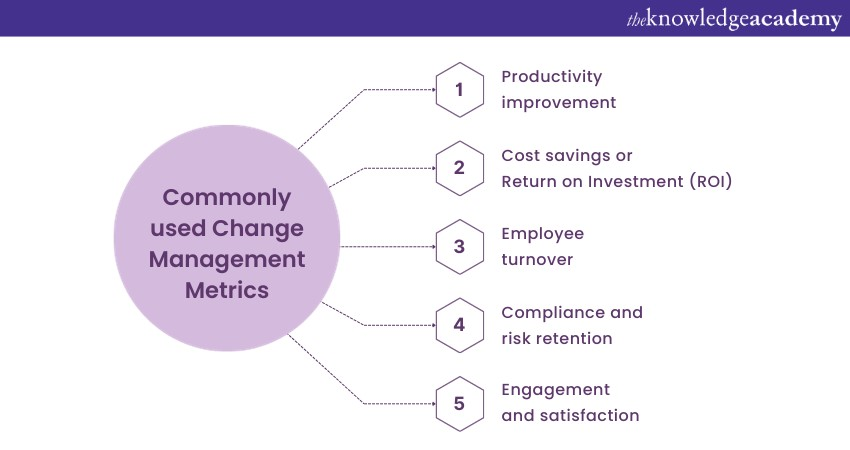We may not have the course you’re looking for. If you enquire or give us a call on +44 1344 203999 and speak to our training experts, we may still be able to help with your training requirements.
Training Outcomes Within Your Budget!
We ensure quality, budget-alignment, and timely delivery by our expert instructors.

Relevancy and innovation are essential for an organisation's growth and sustainability. Therefore, changes made to achieve these factors also become a vital aspect of an organisation’s management. But if an organisation keeps changing essential elements of their business without managing the impact, they might face a chaotic jumble. This is where change management process and change management models come into play.
Change Management refers to the strategic preparation of an organisation towards change through the implementation of a change management plan. It involves preparing, helping, and leading a team towards a changing environment. But how do you manage changes without measuring their impact? That is where Management Metrics come in. In this blog, we will understand what Change Management Metrics are, their complexity and how different metrics are used to determine various aspects of a business.
Table of Contents
1) Complexity of Change Management Metrics
2) Metrics for measuring Change Management
3) Success through Change Management perspective
4) Commonly used Change Management Metrics
5) Change Management Metrics examples
6) Conclusion
Complexity of Change Management Metrics
In the past few decades, organisations have seen a rise in factors like globalisation and technological advancements. Although these changes in the working environment paved the way for the evolution of many industries, they also increased the complexity and turbulence in the working environment. Many organisations even made fundamental changes to achieve higher goals, making complexity and turbulence the drivers behind changes. Change management principle aid in selecting the right metrics and interpretation of those metrics.. So, what is complexity and turbulence exactly?
Tired of being inefficient and looking for the necessary changes in your organisation? Check out our Change Management Training Courses!
Turbulence and complexity
Turbulence occurs when changes in industry occur at a tremendous pace, and organisations need to cope with the speed to sustain and evolve themselves. Technological companies are the perfect example of turbulence because their hardware and software constantly deliver innovative features to exploit the market.
On the other hand, complexity occurs when an organisation encounters multiple possibilities while making a decision. These decisions are also interconnected with other essential aspects of the organisation. An example of understanding complexity can be an organisation looking to add more steps to a process.
The organisation can either re-evaluate the earlier approach, eliminate inefficient steps, implement critical changes, etc. All these changes represent alternatives to the original method. When we talk about Change Management Metrics, we need to understand what drives these changes in the first place.
To understand this further, let us dive into the types of environments that organisations cope with. Understanding different environments will help us understand the complexity behind Change Management Metrics.
a) Stable environment: Although many industries see rapid advancement in technology and growth, some industries remain constant for years. Such industries encounter low complexity as well as low turbulence. These organisations usually have a lower impact on change and, thus, require less effort. However, according to Change Management Metrics, the changes in these organisations are slightly incremental.
b) Turbulence environment: Some organisations require quicker results in order to sustain themselves, but they do not need more complexity. In this environment, Change Management Metrics generally deal with technical or structural issues.
Discover the Best Change Management Books! Read our top picks and transform your organization today!
c) Complex environments: A complex environment is an environment where organisations are required to analyse data thoroughly before making rational conclusions. Turbulence is usually very low in these environments.
d) Complex and turbulent environment: A complex and turbulent environment occurs when organisations quickly react to emergency situations and implement changes without much data. Witnessing frequent changes is considered normal in this environment and requires the application of deliberate Change Management activities.
A new product development is a perfect example of this environment. Whenever a new product is launched, both the process and stakeholders behind the product can be affected by it, making Change Management Metrics highly valuable.
Get ready for your interview with our top Change Management Interview Questions.
Metrics for measuring Change Management
Measuring Change Management depends on what values and measurements are the most useful for an organisation. Once an organisation figures out these values, change management tools are used to measure them throughout the project to ensure that the desired results are achieved. Let us have a look at different types of metrics for measuring Change Management:

a) Measuring organisational performance: Organisational performance measures figure out how effectively an organisation is accomplishing all of its goals. It can also help a business determine if its resources are being used suitably or not.
b) Measuring individual performance: Measurement of individual performance demonstrates how an individual is dealing with the ongoing change. Now that measuring the performance of an individual is the smallest measurement, it can become a leading indicator of the entire organisation's success. Although this is an effective way of measurement, it is widely used to demonstrate the efficiency of Change Management. This method is popularly used in servers, operations and performance evaluation.
c) Measuring Change Management performance: The metrics in this category are concerned with the activities happening in the Change Management team. Although it is essential to keep an eye on this category, individual and organisational performance determine its results because they are directly related to management activities.
Discover the Impact of Change Management Salaries on Career Growth and Organizational Success!
Success through Change Management perspective
Success through a Change Management perspective depends upon Tactical effectiveness and adoption effectiveness. Let us understand what thoroughly:
Tactical Effectiveness
Tactical Effectiveness estimates the efficiency of tactical Change Management activities that occurred at various points while completing a project. This is why it is often measured each activity. The importance of tactical effectiveness comes from the fact that sometimes, we fail to determine the effectiveness of activities in achieving goals. There are many reasons behind this drawback, but the most common notion is to think that this is the only way these things have always been done.
Using tactical effectiveness offers an opportunity to grow through feedback, which can be later used to make competent plans. Tactical metrics are often used to evaluate the post-training of new employees and build strong communications.
Changes offer a chance to improve, learn and grow. Register for our Change Management Foundation Course and gain necessary skills today.
Adoption Effectiveness
Unlike tactical effectiveness, which is evaluated after every activity, adoption effectiveness is calculated after completing the entire project or at the end. The importance of measuring this effectiveness is to figure out if the people who were involved in this project are capable of handling future projects. Let us have a look at the primary features of adaptive effectiveness.
a) Adoption: Adoption works on changes that are not mandatory. The use of metrics in adoption is to figure out if the methods are adopted effectively or even at all after the implementation. It is a very effective way to figure out whether or not the new system is capable and much more effective than the previous systems. Adoption is usually used when stakeholders have older procedures to fall back on.
b) Competency: The use of competency is to figure out how efficiently the adopted method or system works. An example of a lack of competency can be a new system that can hold a high volume of logins at a time, but the audience is unable to use the most important features it offers efficiently. When we track the system constantly and find out the loopholes, we can analyse if replacing the older system with the new one as actually beneficial.
c) Perception: The aim of any change or transformation is to achieve targets that specifically have a positive impact on stakeholders. Adoption and perception are very important for analysing the effectiveness and efficiency of a system, but it also important to find out how is the new system being perceived by the stakeholders using it. Stakeholders' perceptions toward the change determine whether the desired result was achieved.
Dive into the detailed Case Study on Change Management.
Commonly used Change Management Metrics
Measuring changes in an organisation requires the use of multiple metrics. Each metric defines its own value in terms of whether the changes have a positive effect on key aspects of the process and the product or service itself. Let us understand some of the essential and commonly used metrics.

Productivity improvement
Productivity in an organisation is defined by assessing if the new changes in the process resulted in increased outcomes. This increase in outcome can vary from business to business. For example, an increase in output for one organisation can be an increase in products with minimum error, while for the other, it can increase the number of clients gained daily.
Cost savings or Return on Investment (RIO)
Financial metrics offer a clear and easy answer to whether or not the changes made were successful. These changes in an organisation are mostly made to make the process more efficient, to technological advancements, or to relocate the resources. Using easy financial metrics like sales revenue is good enough if minor changes don’t require much change. But when a company invests higher capital and implements significant changes, calculating RIO becomes very important.
Employee turnover
Your organisation's reliable and qualified employees are essential for growth and sustainability. Employee turnover metrics examine how many employees leave the organisation at a particular time. The reason for leaving the organisation can be voluntarily or getting fired or laid off. If an organisation has a higher employee turnover rate, there needs to be more reliability and trust amongst the organisation and its employees. Taking these metrics lightly may cause inefficiency and a massive loss of productivity.
Compliance and risk retention
Adhering to government or other regulations is essential for an organisation to keep their employees safe and prevent injuries as well as substantial error losses. It is also necessary that the organisation itself find methods to decrease associated risks. Compliance and risk retention metrics calculate how effectively an organisation follows and makes rules for the health and safety of its employees. The higher the value of compliance and risk retention, the higher the result of Change Management.
Engagement and satisfaction
It is essential to figure out if the person affected by a change is satisfied by it or not. Engagement and satisfaction metrics capture the feelings and perceptions of the people directly affected by a change. This metric is conducted through surveys, feedback and focus groups. When engagement and satisfaction rate is higher, organisations witness a smooth and easy transition in change.
Change Management Metrics examples
Now that we understand the concept of Change Management Metrics let us study a few live examples that will provide you with a clearer picture of the topic:
a) Resistance level: We can use resistance level metrics during essential stages of an organisation to raise critical concerns. An example can be the HR department tracking down all the previous complaints filed by the employees and which areas the new company needs to work on. This process can quickly figure out different sectors that need improvement in an organisation.
b) Training completion: For industries that undergo a process like manufacturing, training becomes vital to ensure everyone’s safety. Tracking down the percentage of people who underwent proper training helps the organisation implement health and safety regulations and causes minimum errors.
c) Compliance: While manufacturing products, an organisation needs to be concerned about essential aspects of a product, like product labelling. A process like product labelling assures the reliability of the product.
Conclusion
In Change Management Metrics, using different metrics depends on specific goals. If the goal is to determine the reason behind employees' inefficiency, engagement and satisfaction metrics may offer a suitable reasoning. On the other hand, if an organisation wants to understand production, productivity metrics can provide reliable data. Different metrics have different and vital uses; organisations use them to grow and innovate efficiently.
Enhance the scope of success and productivity with our Change Management Practitioner Course!
Frequently Asked Questions
Upcoming Project Management Resources Batches & Dates
Date
 Change Management Foundation & Practitioner
Change Management Foundation & Practitioner
Thu 1st Jan 1970







 Top Rated Course
Top Rated Course



 If you wish to make any changes to your course, please
If you wish to make any changes to your course, please


